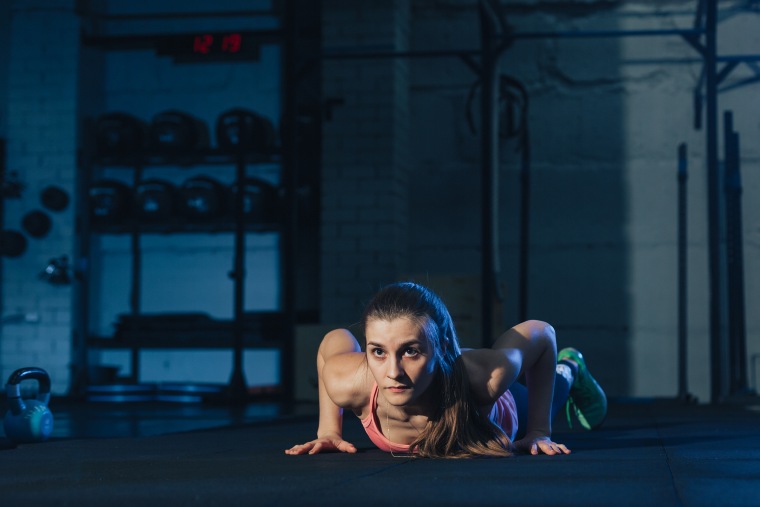Welcome to Start TODAY. Sign up for our free Start TODAY newsletter to receive daily inspiration sent to your inbox — and join us on Instagram!
Cardio workouts are essential to maintaining your health and fitness level. The American Heart Association recommends adults get "at least 150 minutes per week of moderate-intensity aerobic activity or 75 minutes per week of vigorous aerobic activity" — or a combination of both.
To gain even more benefits, they recommend being active at least 300 minutes (or 5 hours) per week.
Is having that kind of time to exercise a pipe dream? If you're time-strapped, being able to put in half the time and reap the same benefits is probably appealing. Luckily, there is a way to do just that. Enter: HIIT workouts.
HIIT stands for high-intensity interval training and it’s one of the most popular forms of exercise, in part due to its high effectiveness in a short amount of time.
What is HIIT?
High-intensity interval training is a challenging workout performed at an intense level.
Interval training means exercises are done in bursts with short recovery periods in between. They can start slow and become faster from one exercise to another. Typically, cardio and strength training are combined to create a well-rounded high-intensity interval training workout.
HIIT workouts will spike your heart rate and push your muscles to the point of fatigue. By combining high-intensity bursts of cardio, brief rests and circuit-style strength training, you keep your body guessing. In this way, HIIT workouts are strategically designed to help you get an efficient workout in a shorter amount of time than low-intensity steady state cardio.
Benefits of HIIT
The health benefits of high-intensity interval training include boosting your metabolism, burning calories (which can encourage weight loss), and building strength and muscle. Because there are hardly any pauses in a HIIT workout, you can reap these benefits in less than half the time of steady-state exercise.
Other benefits of HIIT include an increase in muscle mass, better oxygen consumption, reduced blood sugar and improved blood pressure.
Research also shows that interval training like HIIT is best for fat loss. HIIT training not only increases your metabolism during the workout, but it stays elevated after the workout is complete, meaning your body is burning more calories at rest.
Are HIIT workouts for beginners?
HIIT can be an appropriate way for most people to train, including both men and women and those of any age. Because HIIT is highly efficient, it is great for those who don't have a lot of time to reap the benefits of exercise and makes it easier to commit to fitness on a consistent basis.
But it's important to remember that HIIT is so effective because it is challenging. It's always smart to tailor your workouts to your fitness level and goals.
Be aware of any physical limitations and adjust accordingly. While, many HIIT routines will have high-impact movements, that's not a requirement. High intensity doesn’t have to mean high impact. If you suffer from joint issues or pain, you should incorporate low impact, but high intensity, exercises like speed squats, mountain climbers and marching in place. If you have no joint issues or pain, you are safe to experiment with higher-impact exercises like high knees, jumping jacks and burpees. As always you should consult your doctor before starting any exercise program.
Take your lifestyle into consideration, as well. If you are stressed and have elevated cortisol levels, a HIIT workout (which also taxes the body) may not be the best option for you. If you push yourself to your max effort during cardio bursts, it does place stress on the body and elevated cortisol can hinder weight loss. So instead of doing a full out sprint or a super intense cardio burst, opting for lower-intensity cardio may be a healthier choice for you.
HIIT workouts at home
You don't need to shell out money for a pricey gym class to try a HIIT workout. In fact, any form of movement can be done HIIT style, whether you’re doing pure cardio, like walking or jogging, or doing strength exercises.
- Cardio: Adding intervals to your cardio routine is a simple way to start experimenting with HIIT training. If you’re currently doing steady-state cardio like walking, add intervals by playing with speed. For example, walking at a slow pace for one minute, followed by a fast pace for one minute.
- Strength: Another way to incorporate HIIT into your workout is to alternate between strength exercises and bursts of cardio. This could look like doing a strength exercise (like squats) for one minute, then going into a one-minute cardio burst (like high knees), and alternating like this between cardio and strength for the duration of your workout.
HIIT workouts for beginners
You can easily turn your walk or strength session into a HIIT routine. Here are two sample workouts to try:
HIIT cardio workout
If you’re a walker, follow this HIIT routine:
- Warm up: Walk at a normal pace for 3 minutes.
- 1-minute speed: Walk at a fast pace. (You can also measure by distance. For example: Walk for one block or a quarter mile at a quicker pace.)
- 1-minute recover: Walk at a slower pace.
Alternate between the speed and recovery rounds for the duration of your walk before cooling down.
HIIT strength workout
If you’re doing strength training, follow this HIIT routine:
- Warm up: Do 3 minutes of steady-state cardio like walking or marching in place.
- 1-minute strength: Perform 3 strength exercises for 10 repetitions each. You could do 10 squats, 10 pushups and 10 bicep curls.
- 1-minute cardio: Perform a cardio burst, like running in place, doing squat jumps, or getting on the elliptical and moving quickly.
Alternate between the strength and cardio rounds for the duration of your workout before cooling down.

